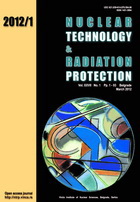
A PROPOSAL FOR A NEW U-D2O CRITICALITY BENCHMARK: RB REACTOR CORE 39/1978
Pages: 75-83
Authors: Milan P. Pešić
AbstractIn 1958, the experimental RB reactor was designed as a heavy water critical assembly with natural uranium metal rods. It was the first nuclear fission critical facility at the Boris Kidri~ (now Vin~a) Institute of Nuclear Sciences in the former Yugoslavia (now Serbia). The first non-reflected, unshielded core was assembled in an aluminum tank, at a distance of around 4 m from all adjacent surfaces, so as to achieve as low as possible neutron back reflection to the core. The 2% enriched uranium metal and 80% enriched uranium dioxide (dispersed in aluminum) fuel elements (known as slugs) were obtained from the USSR in 1960 and 1976, respectively. The so-called "clean" cores of the RB reactor were assembled from a single type of fuel elements. The "mixed" cores of the RB reactor, assembled from two or three types of different fuel elements, were also positioned in heavy water. Both types of cores can be''composed as square lattices with different pitches, covering a range of 7 cm to 24 cm. A radial heavy water reflector of various thicknesses usually surrounds the cores. Up to 2006, four sets of clean cores (44 core configurations) have been accepted as criticality benchmarks and included into the OECD ICSBEP Handbook. The RB mixed core 39/1978 was made of 31 natural uranium metal rods positioned in heavy water, in a lattice with a pitch of 8 x 2½ cm and 78 x 9 low enriched uranium metal slugs placed in heavy water in lattice pitches of 8 x 2½ cm and 8 x 2 cm. This RB multipart core has now been proposed to the ICSBEP as a possible new U-D2O criticality benchmark, due to its complex irregular lattice which is almost impossible to simulate by computer codes that require axial symmetry or a regular lattice. Criticality results presented in this paper were obtained in calculations carried out by using recent versions of the MCNP5 and KENO V.a computer codes and various libraries of the neutron cross-sections data. Our results confirm that the proposed RB reactor complex core, RB 39/1978, may well prove to be a new U-D2O benchmark criticality system for validating reactor design computer codes and data libraries recommended by the ICSPEP.
Key words: RB critical assembly, heavy water, criticality benchmark
FULL PAPER IN PDF FORMAT (9,05 KB)
